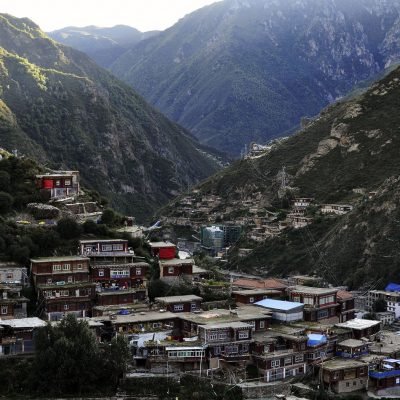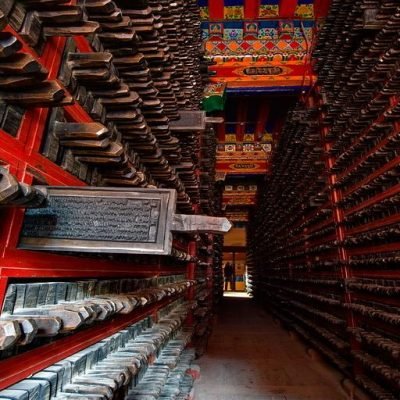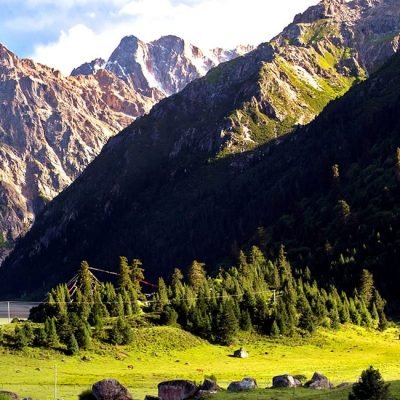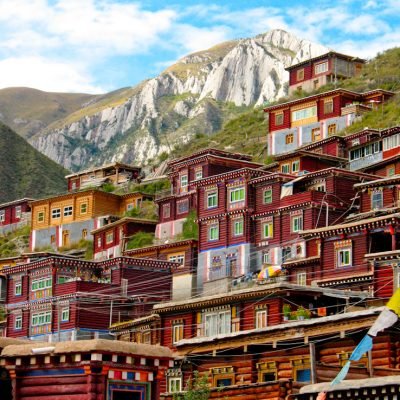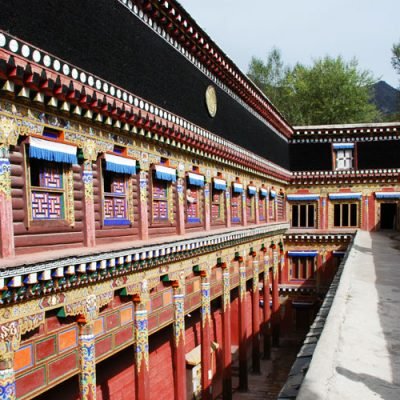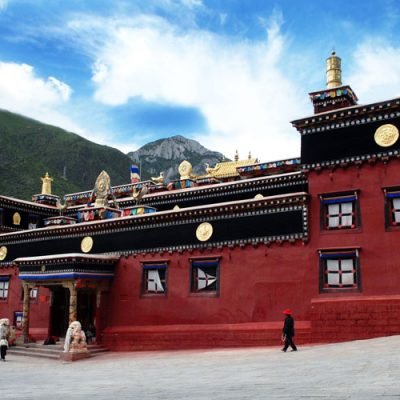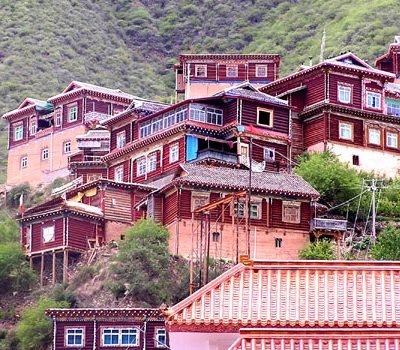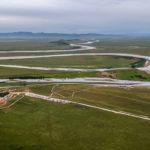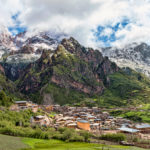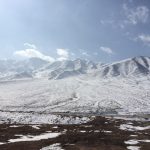The historic town of Dege makes up one of the five former great kingdoms of the Kham Tibetan area and many describe this town as the “heart of Kham”. Dege sits in a narrow valley at 3100 meters (10,170 ft) surrounded by mountains and the Sèqū River色曲河 that runs through the town. The city is famous for its Tibetan lamasery which hosts an invaluable treasury of wooden printing blocks with Tibetan Buddhist texts. About 70% of all Tibetan scriptures used across the Tibetan Plateau are produced in this very important printing press. A cultural center (more like a high end gift shop) has opened near the Printing Press & Monastery. Nevertheless the surrounding quarters on the valley’s slopes still preserve the old Tibetan traditions including the temple complex that contains a maze of wonderful old style Tibetan buildings made from rammed earth and logs. If you come here for nothing but the old log-cabin style buildings the trip would be absolutely worth it! This is one of the only places in all of Tibet where you can find such unique architecture, mainly because it is one of the only places that actually had any sizable forest.
If driving from the north, from Yushu, Serxu, Ganzi, or from Qinghai Province, Dege can be reached via the incredible, infamous Trola Pass.. The road between Ganzi and Dege is beautifully paved with the exception of the 5050 m high Tro-la Pass which is in disrepair with many potholes. Also be warned that this high road over the Trola Pass can be very dangerous in the snow or ice so check weather conditions before you set out on your trip. Parts of the pass also wind up the mountain and have no shoulder or railing with a drop of several 100 meters below. So this is not a drive for the fainthearted or inexperienced. But the incredible views from Ganzi over the Trola Pass (5050 m elevation) make the grueling day trip over Trola pass worthwhile.
Coming from the south, one can enter Dege from a route from Chengdu to Kangding. Reconstruction work on the Kangding (Dartsedo) to Ganzi highway (G317 / S303) is complete as of 2014 and the road from Kangding to Dege is now well paved. Dege to Kangding is now a one day journey by bus. You can leave Dege on a public bus at 6am and then arrive in Kangding around 8 or 9 pm. If you have your own 4WD car, Chengdu to Dege can also be driven in one long, epic day, but this is a very good way to get altitude sickness with a very quick ascent from Chengdu at 500 meters to Dege at 3,100 meters . It is recommended to stop at least one night in Kangding to acclimatize.
A new airport called Ganzi Gesar Airport(甘孜格萨尔机场) is about 60 km from Garze; 15 km from Manigango village. As of Spring 2016 this airport was almost finished and certainly presents the quickest (albeit not the cheapest) way to get from Chengdu to Ganzi to Dege.
Derge Gonchen monastery
Derge Gonchen monastery was founded in 1446 by Yogis Hang Stong Rgyal Po and the first local king Bo. It doubled as a palace for the kings, but is most famous for being one of the cradles of Tibetan Buddhist study and practice. Unfortunately, there are only a few old buildings remaining and the newer ones aren’t all that attractive in a sense of ancient architecture. Head farther uphill from the Printing Yard along the river following a road lined with Stupas. The entrance to the main temple is in the big red building on the left.
Dege Buddhist Scriptures Printing House
The Dege Buddhist Scriptures Printing House (Tibetan: Derge Parkhang) is independent from the monastery and is the first substantial building you’ll encounter walking south from the town’s center along the river. The Printing House is in a beautiful traditional temple which was restored in 1991. It is constantly circumambulated by townspeople and pilgrims. Here the admission fee is ¥50/person, and normally photography of the sections with the printing blocks is not allowed, though you can take pictures of the printing process. It is always worth asking your guide if it’s allowed to take a particular photograph as the rules change from time to time. The institution was founded in 1729 by Chogyal (dharma king) Denba Tsering. There are more than 140,000 printing blocks, a large collection of national cultural relics and a library comprising 830 books consisting of 10000 volumes. The last surviving copy of an old history of Indian Buddhism is amongst them. Inside you can wander the corridor lined with shelves accommodating the printing blocks and their protruding wooden handles. On the 3rd floor there is the workshop where 6 or 7 pairs of workers ink the blocks and press the paper on them with amazing speed. This is truly a glimpse into the printing techniques of a bygone era. On the next floor, the prints are dried and then assembled into books. In an extra chamber, large format pictures and scripts are printed on cloth. Once you make your way to the top of the printing press the roof offers nice views over the surrounding Tibetan neighborhood and the new town. A tour of the dark temple concludes the visit.
From the Printing House head west into the old quarter and follow a path leading down to the river. Hidden within a maze of traditional houses you will find the Tangtang Gyalpo Lhakhang, a tiny temple. Most any time of day you can find monks inside chanting scripture.
Dege is certainly worth at least 2 nights stay as a semi-halfway point on a long road trip between Xining and Chengdu. This is a great place to take a rest day along your long journey or to explore the printing press and stroll back through time as you wind through alleys full of handmade red wooden log homes.
